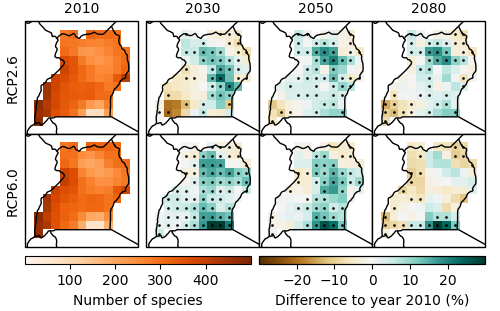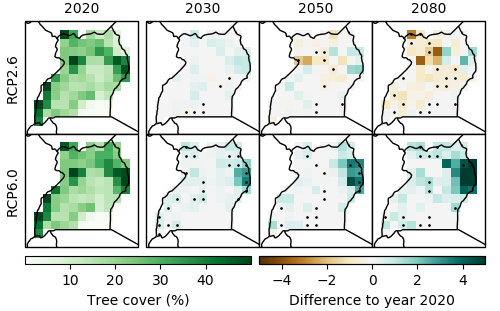Uganda: Ecosystems
Climate change is expected to have a significant influence on the ecology and distribution of tropical ecosystems, though the magnitude, rate and direction of these changes are uncertain [27]. With rising temperatures and increased frequency and intensity of droughts, wetlands and riverine systems are increasingly at risk of being converted to other ecosystems with plants being succeeded and animals losing habitats. Increased temperatures and droughts can also impact succession in forest systems while concurrently increasing the risk of invasive species, all of which affect ecosystems.
Species richness

Model projections of species richness (including amphibians, birds and mammals) and tree cover for Uganda are shown in Figure 15 and 16, respectively. Changes depend on the region and scenario: Under RCP2.6, species richness is projected to increase by 15 % in central Uganda and decrease by 10 % in the south-west and north-east of the country, while under RCP6.0, projections indicate an increase by 20 % in south-eastern Uganda and a decrease by 10 % in the west and north-east of the country, with higher modelling uncertainty (Figure 15).
Tree cover

Tree cover projections for Uganda are also characterised by high modelling uncertainty. Models tend to project a slight increase of up to 5 % under RCP6.0, especially in eastern Uganda, and a slight decrease of up to 4 % under RCP2.6, which can be observed in various small patches across the country (Figure 16).
It is important to keep in mind that the model projections exclude any impacts on biodiversity loss from human activities such as intensive land use and land use change, which have been responsible for significant losses of global biodiversity in the past, and are expected to remain its main driver in the future [28]. In Uganda, the need for new settlements and land for cultivation threaten tree cover and biodiversity with high rates of deforestation: Uganda has lost 844 000 ha of forest cover in the period from 2001 to 2019, which is equivalent to an 11 % decrease since 2000 [29].
References
[27] T. M. Shanahan, K. A. Hughen, N. P. McKay, J. T. Overpeck, C. A. Scholz, W. D. Gosling, C. S. Miller, J. A. Peck, J. W. King, and C. W. Heil, “CO2 and Fire Influence Tropical Ecosystem Stability in Response to Climate Change,” Nat. Publ. Gr., no. July, pp. 1–8, 2016.
[28] IPBES, “Report of the Plenary of the Intergovernmental Science-Policy Platform on Biodiversity and Ecosystem Services on the Work of Its Seventh Session,” n.p., 2019.
[29] Global Forest Watch, “Uganda,” 2018. Online available: https://www.globalforestwatch.org [Accessed: 03-Mar-2020].


